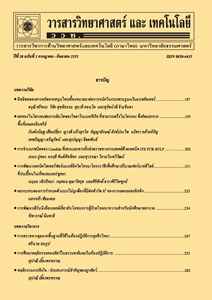ผลของสารควบคุมการเจริญเติบโตต่อการชักนำให้เกิดและการเจริญเติบโตของแคลลัสองุ่นสำหรับการผลิตสารทุติยภูมิ
Main Article Content
Abstract
Abstract
Grape (Vitis vinifera) is a fruit with antioxidant properties because of polyphenols compounds, the important secondary metabolites. Polyphenols can inhibit the causes of various types of cancer and also reduce cholesterol, reducing the risk of heart disease. Therefore, this research aims to study the effect of plant growth regulators on callus induction and growth for secondary metabolite production by cell culture technique. The effect of growth regulators on the induction and growth of callus from grape explants which cultured on Murashige and Skoog (MS) supplemented with growth regulators as N6-benzyladenine (BAP) and napthaleneacetic acid (NAA). From the result, MS supplemented with BAP and NAA at concentrations of 1 and 0.5 mg/L, respectively can induce callus formation. Moreover, the effects of BAP at different concentrations on callus growth at 4 weeks were studied. The MS medium supplemented with BAP at 1.5 mg/L was suitable for grape callus growth which showed the highest of fresh weight, 3.70±0.53 g. Then the callus extract was analysis of compounds through TLC techniques. The result showed that grape callus comprised of resveratrol and exhibited DPPH radical scarvenging activity EC50 of 21.38 µg/ml.
Keywords: grape; callus; growth regulator; secondary metabolite; antioxidant activity
Article Details
References
[2] God, J.M., Tate, P. and Larcom, L.L., 2007, Anticancer effects of four varieties of muscadine grape, J. Med. Food 10: 54-59.
[3] Shanmuganayagam, D., Warner, T.F., Krueger, C.G., Reed, J.D. and Folts, J.D., 2007, Concord grape juice attenuates platelet aggregation, serum cholesterol and development of atheroma in hyper cholesterolemic rabbits, Atherosclerosis 190: 135-142.
[4] Dias, M.I., Sousa, M.J., Alves, R.C. and Ferreira, I.C.F.R., 2016, Exploring plant tissue culture to improve the production of phenolic compounds: A review, Indust. Crops Prod. 82: 9-22.
[5] Saw, N., Riedel, H., Cai, Z., Kütük, O. and Smetanska, I., 2012, Stimulation of anthocyanin synthesis in grape (Vitis vinifera) cell cultures by pulsed electric fields and ethephon. Plant Cell, Tissue Organ Cult. 108: 47-54.
[6] Marwani, E., Wardhani, K., and Esyanti, R., 2015, Development of hairy root culture of Andrographis paniculata for in vitro adrographollide production, J. Med. Bioeng. 4: 446-450.
[7] Loc, N.H. and Nhat, N.T.D., 2013, Production of asiaticoside from centella (Centella asiatica L. Urban) cells in bioreactor, Asian Pac. J. Trop. Biomed. 3: 806-810.
[8] Kaewpiboon, C. and Lohasupthawee, P., 2004, Effect of plant growth regulators to the differentiation and development of grape callus, King Mongkut's institute of Technology Ladkrabang, Bangkok.
[9] Hosseini, S.M., Bahramnejad, B., Douleti Baneh, H., Emamifar, A. and Goodwin, P.H., 2017, Hairy root culture optimization and resveratrol production from Vitis vinifera subsp. sylvesteris, World J. Microbiol. Biotechnol. 33: 67.
[10] Cetin, E.S., 2014, Induction of secondary metabolite production by UV-C radiation in Vitis vinifera L. Okuzgozu callus cultures, Biol. Res. 47: 37.
[11] Köse, C. and Güleryüz, M., 2006, Effects of auxins and cytokinins on graft union of grapevine (Vitis vinifera), New Zealand J. Crop Hort. Sci. 34: 145-150.
[12] Shirani Bidabadi, S., Afazel, M. and Sabbatini, P., 2018, Iranian grapevine rootstocks and hormonal effects on graft union, growth and antioxidant responses of Asgari seedless grape, Hort. Plant J. 4: 16-23.
[13] Kaewpiboon, C., Lirdprapamongkol, K., Srisomsap, C., Winayanuwattikun, P., Yongvanich, T., Puwaprisirisan, P., Svasti, J. and Assavalapsakul, W., 2012, Studies of the in vitro cytotoxic, antioxidant, lipase inhibitory and antimicrobial activities of selected Thai medicinal plants, BMC Complement Altern. Med. 12: 127.
[14] Seung-Heui Kim, S.K.K., 2002, Effects of auxins and cytokinins on callus induction from leaf blade, petiole and stem segment of in vitro-grown Sheidan grape shoots, J. Plant Biotechnol. 4: 17-21.
[15] Khan, N., Ahmed, M., Hafiz, I., Abbasi, N., Ejaz, S., Anjum, M., 2015, Optimizing the concentrations of plant growth regulators for in vitro shoot cultures, callus induction and shoot regeneration from calluses of grapes, OENO One 49: 37-45.
[16] Keskin, N. and Kunter, B., 2008, Production of trans-resveratrol in 'Cabernet Sauvignon' (Vitis vinifera L.) callus culture in response to ultraviolet-C irradiation, Vitis 47: 193-196.
[17] Cai, Z., Kastell, A., Speiser, C. and Smetanska, I., 2013, Enhanced resveratrol production in Vitis vinifera cell suspension cultures by heavy metals without loss of cell viability, Appl. Biochem. Biotechnol. 171: 330-340.
[18] Esna-Ashari, M. and Mahmoodi Pour, A., 2011, Effect of methyl jasmonate on resveratrol production in organs and cell suspension cultures of two Iranian grapevine (Vitis vinifera L.) cultivars, J. Hort. Sci. Biotechnol. 86: 557-562.
[19] Vuong, T.V., Franco, C. and Zhang, W., 2014, Treatment strategies for high resveratrol induction in Vitis vinifera L. cell suspension culture, Biotechnol. Rep. 1-2: 15-21.
[20] Fauconneau, B., Waffo-Teguo, P., Huguet, F., Barrier, L., Decendit, A. and Merillon, J.M., 1997, Comparative study of radical scavenger and antioxidant properties of phenolic compounds from Vitis vinifera cell cultures using in vitro tests, Life Sci. 61: 2103-2110.


